|
|
|
| My Favourite Planet > English > Europe > Greece > Attica > Athens > galleries > Acropolis |
|
| |
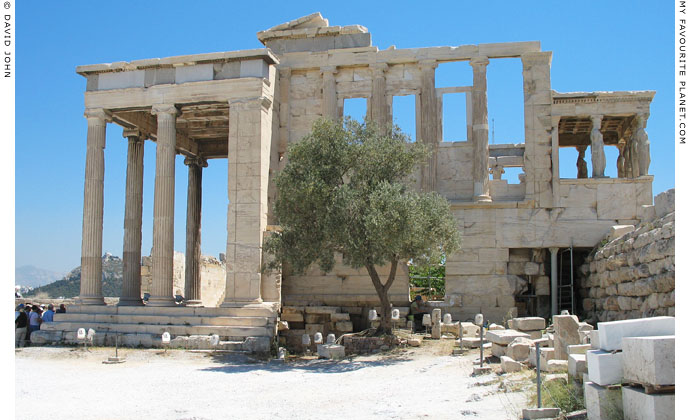
The west side of the Erechtheion. On the left the north porch, to the right the Caryatid porch. |
The west and north sides of the Erechtheion are reached by the footpath descending from the centre of the Acropolis, left (north) as you walk from the entrance (the Propylaia) on the west side.
The visitor enters the sanctuary courtyard around the north of the temple, which is at a level around 3 metres lower than the south side of the building. To the right is the wall marking the boundary between the two levels, above which stands the Caryatid Porch (see gallery page 24). The Kekropeion (Κεκρόπειον), the tomb of the mythological king Kekrops, may have stood next to the wall (see below and the plan of the building and the sanctuary area on gallery page 18). However, according to another theory, it may have been housed in or beneath the Caryatid Porch.
In the centre is the west cella of the building, with a row of five Ionic columns, between which are windows (see gallery page 20). In front of it stands an olive tree, planted by archaeologists to mark the place where, according to ancient tradition, Athena planted the first olive as a gift to the Athenians, and thus won the contest with Poseidon to become the patron deity of the city.
"About the olive they have nothing to say except that it was testimony the goddess produced when she contended for their land. Legend also says that when the Persians fired Athens the olive was burnt down, but on the very day it was burnt it grew again to the height of two cubits [1 metre]."
Pausanias, Description of Greece, Book 1, chapter 27, section 2. [1]
On the left (north) is the tall Ionic north porch (see below and gallery page 21), which projects from the north of the building and also to its west side. Inside the porch is the doorway to the west cella (see gallery page 22).
Both the porch and the main building orginally had sloped roofs with pediments. Along the top of the entablatures of the cella and porch run frieze blocks of grey Eleusinian limestone to which figurative reliefs sculpted in white marble were affixed (see the reconstruction drawing on gallery page 23). Only fragments of these reliefs have been found and the subjects of the friezes are unknown, but may have been mythological scenes. [2]
Although the Erechtheion now looks rather battered, despite extensive restoration, it was once an elegant temple covered with elaborate decoration. The finely carved details of the surviving columns and the doorway are faint reminders of its former grandeur.
The Pandroseion, the sacred area of Pandrosos, one of the daughters of Kekrops (see gallery page 5), is thought to have stood immediately to the west of the Erechtheion (see the plan on gallery page 18). The back wall of this sanctuary may have abutted on the southwest corner of the porch. |
|

Detail of an Ionic column
and the entablature of
the north porch. |
| |
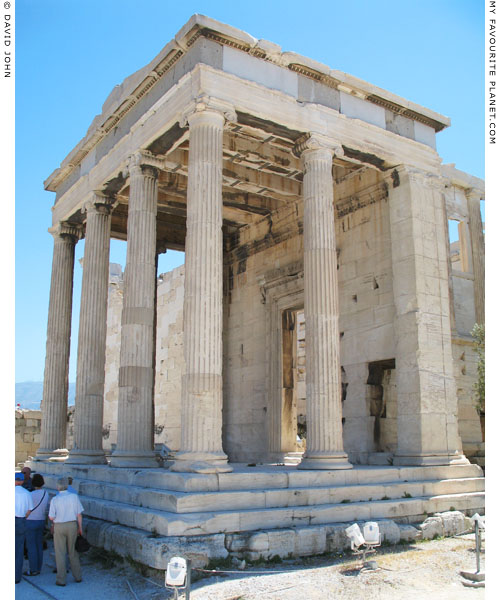
The Ionic porch on the north side of the Erechtheion.
Four steps lead up to the Ionic portico, the roof of which is supported
by six columns, a row of four columns in front and another behind each
of the end columns. The back of the porch is framed by two massive
rectangular pilasters, between which is the elegant doorway to the
cella (see gallery page 22). |
|
| |
 |
|
|
| |
| |
 |
| |
 |
| |
 |
| |
 |
| |
 |
| |
 |
| |
George Alvanos
rooms in
Kavala's historic Panagia District
Anthemiou 35,
Kavala, Greece
kavalarooms.gr
|
| |
Olive Garden Restaurant
Kastellorizo,
Greece
+30 22460 49 109
kastellorizo.de
|
| |
Papoutsis
Travel Agency
Kastellorizo,
Greece
+30 22460 49 286
greeklodgings.gr
|
| |
| |
|
|
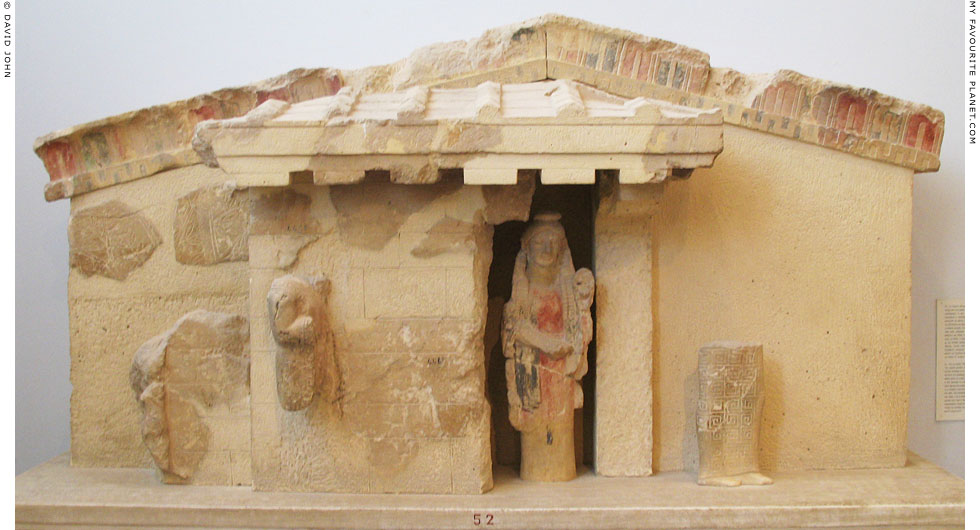
The so-called "Olive Tree Pediment", "Troilus Pediment" or "Fountain House pediment",
a small sculpture group of painted poros limestone from the Athens Acropolis.
Around 575-500 BC. Found in 1888, east of the Parthenon. Height 80 cm, width 148 cm.
Acropolis Museum, Athens. Inv. No. Acr. 52.
|
The small sculpture group, rather like an ancient doll's house or a diorama, has been restored from several fragments. It is thought to have decorated the pediment of an unknown Archaic building on the Athens Acropolis, perhaps the theoretical building known as "Temple A", which may have stood in the area now occupied by the Erechtheion. Another sculpture group of similar size and date, depicting the Apotheosis of Herkales (Acropolis Museum, Inv. No. Acr. 9), may have decorated the pediment at the other end of the same building.
It was first restored the German archaeologist Theodor Wiegand (1864-1936), whose work was continued by Rudolf Heberdey (1864-1936) of the Austrian Archaeological Institute at Athens. The pediment sculptures consist of figures in front of a projecting building or porch covered by a tiled hip roof (i.e with a sloping side where a pediment would be), which is supported at the front by a long wall to the left of the doorway. Above part of a wall (described as a precinct wall) to the left of the porch are fragments of an incised olive tree (hence the name "Olive Tree Pediment").
Only one female figure and fragments of two other females and a male have survived, but the scene probably included a number of others. The torso of one female is affixed to the wall left of the doorway, and the legs of another, wearing an ankle-length gown with geometric decoration, stand to the right of the porch. Only the relief of part of the male's bare leg can be seen at the left of the fragment of wall left of the porch.
The most complete figure is the free-standing sculpture of a woman, who in the reconstruction stands in the doorway, facing outwards. On her head is a disc which has been interpreted as a cushion, and her left arm appears to be raised. This has led to theories that she was either a hydriaphoros (water jug carrier), with her left hand steadying a jug she carried on her cushioned head, or an early Caryatid supporting the roof.
The hydriaphoros theory led to the building being interpreted as a fountain house, which then led to the scene being seen as depicting Troilus being ambushed by Achilles as he watered his horses. The male figure was thus thought to be Troilus (see Homer part 2). It has been argued that this story has no apparent relevance to the Acropolis or the mythological history of Athens, which provided the subjects for much of the building decoration on the Acropolis in the Archaic and Classical periods. However, the story of Herakles being introduced to the Olympian gods (the Apotheosis of Herkales) and other subjects, such as the birth of Pandora on the base of Pheidias' statue of Athena Parthenos, were likewise not directly connected with the Acropolis.
A number of other interpretations have been suggested, including theories that the scene depicts mythological figures connected with the history of Athens, such as Pandrosos, one of the daughters of King Kekrops, or even Erechtheus. According to another theory, it may represent the Panathenaic procession approaching the sanctuary of Athena Polias. The olive tree may represent the olive planted by Athena during her contest with Poseidon for the patronage of Athens. |
|
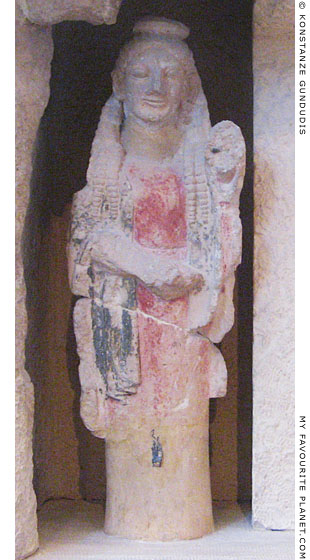
The most complete surviving figure
of the pediment, depicting a female,
who in the reconstruction stands
in the doorway of the building.
Photo: © Konstanze Gundudis |
|
| |
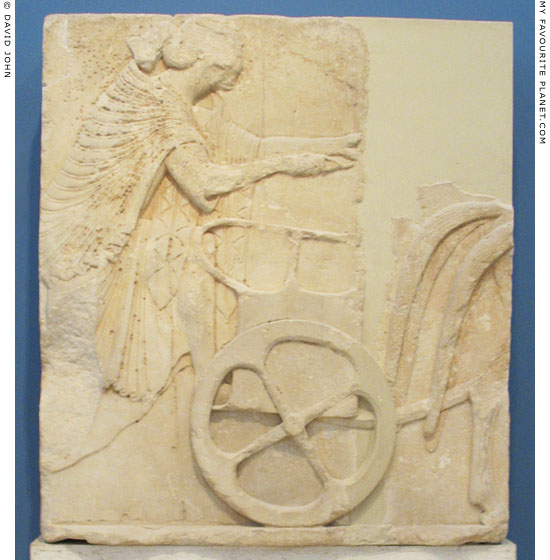
Fragmentary low marble relief of a figure mounting a chariot, perhaps part of
a decorative panel from the Archaic Kekropeion (Κεκρόπειον), around 500 BC.
The left-hand slab was found in 1822 near the Klepsydra spring. The right-hand
slab was found in 1859-1860 at the east end of the Acropolis. Island marble.
Height 120.5 cm, width 107.5 cm, depth 80 cm, depth of relief 3 cm.
Acropolis Museum, Athens. Inv. No. Acr. 1342.
|
The fragments of the relief are badly worn, and the gender and identification of the charioteer have long been subjects of debate; Apollo, Artemis, Athena and a Panathenaic victor have been suggested. The figure, wearing a himation (cloak) over a long, sleeved chiton (tunic), steps on to the chariot with the left foot while holding the reigns with both hands. The hair is bound in a krobylos (κρώβυλος), an elaborate hairstyle popular during the Archaic period. The rear legs of the horses and four tails can be seen.
This relief and another depicting a bearded male, thought to be Hermes (Acropolis Museum, Inv. No. Acr. 1343, see the photo on the Hermes page in the MFP People section), were previously thought to have been part of an Ionic frieze on the Old Temple of Athena Polias, built around 525-500 BC. According to other theories, they may have belonged a monument commemorating the victory over the Chalcidians (around 506 BC, see gallery page 8 and History of Stageira part 3) or an altar of Athena. More recent research suggests that they were decorative panels from the peribolos (περίβολος, perimeter wall) of the Kekropeion (Κεκρόπειον), the tomb of mythical king Kekrops at the northwest of the Old Temple. |
|
| |
| The Erechtheion |
Notes, references and links |
 |
|
1. Pausanias on the Erechtheion
"There is also a building called the Erechtheum. Before the entrance is an altar of Zeus the Most High, on which they never sacrifice a living creature but offer cakes, not being wont to use any wine either. Inside the entrance are altars, one to Poseidon, on which in obedience to an oracle they sacrifice also to Erechtheus, the second to the hero Butes, and the third to Hephaestus. On the walls are paintings representing members of the clan Butadae. There is also inside - the building is double - sea-water in a cistern. This is no great marvel, for other inland regions have similar wells, in particular Aphrodisias in Caria. But this cistern is remarkable for the noise of waves it sends forth when a south wind blows. On the rock is the outline of a trident. Legend says that these appeared as evidence in support of Poseidon's claim to the land.
Both the city and the whole of the land are alike sacred to Athena; for even those who in their parishes have an established worship of other gods nevertheless hold Athena in honour. But the most holy symbol, that was so considered by all many years before the unification of the parishes, is the image of Athena which is on what is now called the Acropolis, but in early days the Polis (City). A legend concerning it says that it fell from heaven; whether this is true or not I shall not discuss.
A golden lamp for the goddess was made by Callimachus. Having filled the lamp with oil, they wait until the same day next year, and the oil is sufficient for the lamp during the interval, although it is alight both day and night. The wick in it is of Carpasian flax, the only kind of flax which is fire-proof, and a bronze palm above the lamp reaches to the roof and draws off the smoke. The Callimachus who made the lamp, although not of the first rank of artists, was yet of unparalleled cleverness, so that he was the first to drill holes through stones, and gave himself the title of Refiner of Art, or perhaps others gave the title and he adopted it as his.
In the temple of Athena Polias (Of the City) is a wooden Hermes, said to have been dedicated by Cecrops, but not visible because of myrtle boughs. The votive offerings worth noting are, of the old ones, a folding chair made by Daedalus, Persian spoils, namely the breastplate of Masistius, who commanded the cavalry at Plataea, and a scimitar said to have belonged to Mardonius. Now Masistius I know was killed by the Athenian cavalry. But Mardonius was opposed by the Lacedaemonians and was killed by a Spartan; so the Athenians could not have taken the scimitar to begin with, and furthermore the Lacedaemonians would scarcely have suffered them to carry it off.
About the olive they have nothing to say except that it was testimony the goddess produced when she contended for their land. Legend also says that when the Persians fired Athens the olive was burnt down, but on the very day it was burnt it grew again to the height of two cubits.
Adjoining the temple of Athena is the temple of Pandrosus, the only one of the sisters to be faithful to the trust."
Pausanias, Description of Greece, Book 1, chapters 26-27. At Perseus Digital Library.
2. The Erechtheion frieze reliefs
Inscription IG II(2) 374, one of the surviving marble steles detailing the accounts for the construction of the Erechtheion, lists amounts of money paid to named sculptors for figures described merely as "youth beside the breastplate", "man leaning on a staff beside the altar"
and "woman with the little girl leaning against her". |
|
|
Photos, illustrations, maps and articles: © David John,
except where otherwise specified.
Additional photos: © Konstanze Gundudis
All photos and articles are copyright protected.
Images and materials by other authors
have been attributed where applicable.
Please do not use these photos or articles without permission.
If you are interested in using any of the photos for your website,
project or publication, please get in contact.
Higher resolution versions are available on request.
My Favourite Planet makes great efforts to provide comprehensive and accurate information across this website. However, we can take no responsibility for inaccuracies or changes made by providers of services mentioned on these pages. |
|
| |
 |
Visit the My Favourite Planet Group on Facebook.
Join the group, write a message or comment,
post photos and videos, start a discussion... |
|
|
| |
| Copyright © 2003-2025 My Favourite Planet | contents | contributors | impressum | sitemap |
| |





















